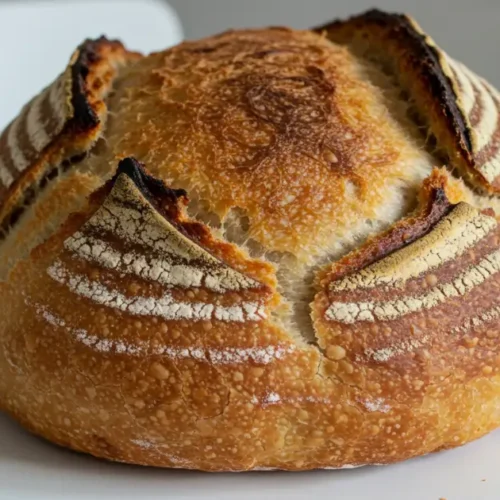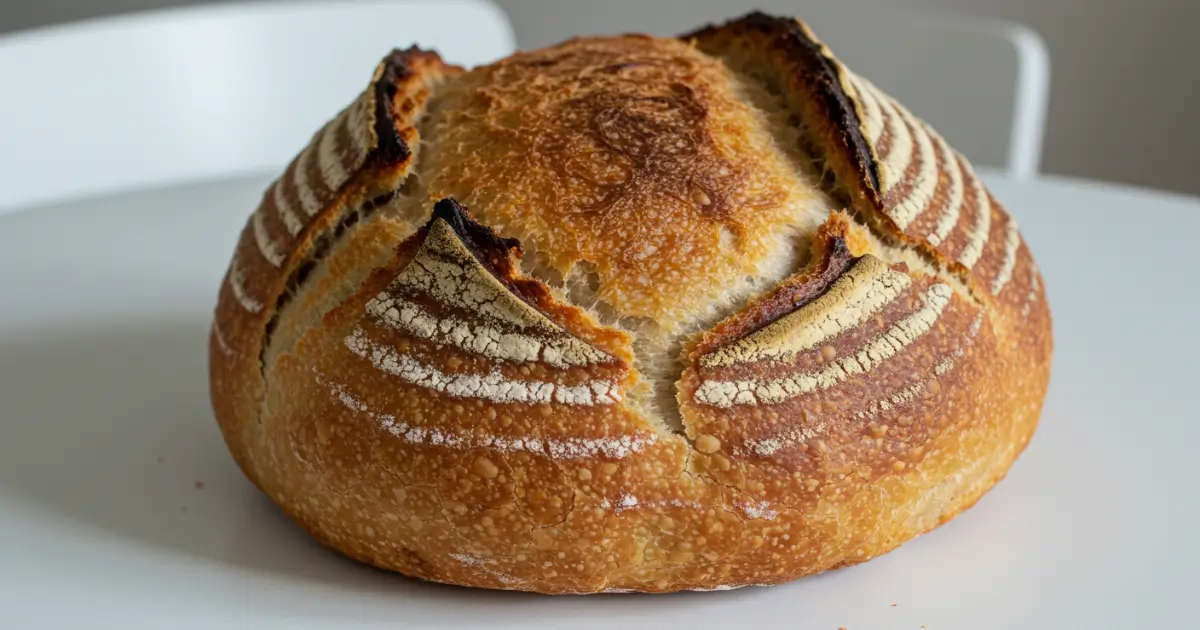Homemade sourdough loaf bread is truly one of the simplest yet most rewarding bakes. With its crispy crust, soft crumb, and unique tang, it’s a must-try for any bread lover. Unlike regular bread, sourdough is made through natural fermentation, offering both delicious flavor and health benefits. Whether you’re new to baking or a seasoned pro, this recipe is easy to follow and will leave you with a perfect loaf every time.
Key Benefits of Sourdough Loaf Bread
Sourdough loaf bread isn’t just delicious; it also comes with a range of health benefits that make it a great choice for your baking adventures. Here’s why you’ll want to add it to your baking list:
Natural Fermentation for Better Digestion: The key to sourdough bread’s unique flavor and texture lies in its natural fermentation process. Unlike regular bread, which uses commercial yeast, sourdough loaf bread is made with a starter that relies on wild yeast and bacteria. This process helps break down gluten, making it easier to digest and reducing bloating.
Probiotic Power: Thanks to fermentation, sourdough bread contains beneficial probiotics that support gut health. These probiotics promote a healthy balance of bacteria in your digestive system, which can lead to improved digestion and overall wellness.
Rich Flavor and Texture: The slow fermentation process not only makes sourdough loaf bread easier to digest but also gives it a complex, tangy flavor that’s hard to beat. The crispy, golden crust combined with a soft, airy crumb makes every slice irresistible.
Versatility in Use: Sourdough loaf bread isn’t just for sandwiches! You can serve it alongside soups, enjoy it with cheese and spreads, or even toast it for breakfast. The possibilities are endless when it comes to using this bread in your meals.
Sourdough bread offers a perfect balance of taste and health benefits. It’s a great way to enjoy a homemade, healthier alternative to regular store-bought bread.

Ingredients for Sourdough Loaf Bread
Sourdough starter – This is essential for sourdough loaf bread, which is made from wild yeast and bacteria. It must be healthy and active for proper fermentation.
All-purpose flour – The main flour used, providing structure and chewiness. High-quality, unbleached flour is recommended for best results.
Whole wheat flour – Adds flavor and nuttiness, enriching the bread’s texture and overall richness.
Salt – Enhances flavor, controls fermentation, and strengthens gluten, contributing to the bread’s texture without making it salty.
Instructions for Sourdough Loaf Bread
Making sourdough loaf bread is a rewarding process that requires patience and care. Follow these steps to achieve a beautifully baked loaf:
Mix the Ingredients: Combine the sourdough starter, all-purpose flour, whole wheat flour, and water in a bowl. Stir until a rough dough forms, and let it rest for 30 minutes.
Knead the Dough: After resting, add salt and knead the dough for 10 minutes until smooth and elastic. Perform the “windowpane test” to check if the dough is ready.
First Rise: Cover the dough and let it rise for 4-6 hours, performing a stretch and fold every hour to strengthen the dough.
Shape the Dough: Once doubled in size, shape the dough into a loaf by folding and pinching it, then place it seam-side down in a proofing basket.
Second Rise: Let the dough proof for 1-2 hours, or refrigerate overnight for a slower rise. Warm up the refrigerated dough for 30 minutes before baking.
Preheat the Oven: Preheat the oven to 475°F (245°C) and heat a Dutch oven inside for a steam effect while baking.
Bake the Sourdough: Transfer the dough to a preheated Dutch oven or baking sheet, score the top, and bake for 20 minutes covered.
Uncover and Bake: Remove the lid and bake for 20-30 minutes until golden brown with a hollow sound when tapped.
Cool and Slice: Let the loaf cool on a wire rack for at least 1 hour before slicing to set the crumb and texture.
Pro Tips for Perfect Sourdough Loaf Bread
Baking sourdough loaf bread is a craft that improves with experience, but there are a few tips and tricks that can help you get the best results every time. These pro tips will take your sourdough game to the next level!
Use a Well-Fed Starter:
Your sourdough starter is key to the success of your loaf. Make sure your starter is active and bubbly before using it. If it’s been sitting in the fridge, give it a few feedings (refreshing it with equal parts flour and water) to make sure it’s strong and ready to go.
Measure Ingredients by Weight:
For the most consistent results, weigh your ingredients rather than using volume measurements. This ensures precision and better control over hydration levels, which can vary based on factors like humidity or the type of flour.
Control the Temperature:
Sourdough is sensitive to temperature, both during fermentation and baking. If your kitchen is cold, consider using a proofing box or turning your oven on to its lowest setting for a few minutes, then turning it off and letting the dough rise inside. For baking, ensure your oven is preheated properly to get that perfect rise.
Don’t Skip the Stretch and Fold:
This step during bulk fermentation is crucial for building structure in your dough. It helps strengthen the gluten without overworking it. Perform the stretch and fold every 30 minutes for the first 2-3 hours of the rise. It’s an easy way to ensure your bread has a great texture and crumb.
Preheat Your Baking Vessel:
If you’re using a Dutch oven, always preheat it in the oven for 30 minutes before placing your dough inside. This mimics the effect of a professional bread oven by trapping steam around the bread, which results in a beautiful rise and crisp crust.
Score Your Dough:
Scoring the top of your sourdough loaf allows it to expand during baking and prevents it from cracking in unpredictable places. Use a sharp blade or a lame to create a pattern that enhances the look of your loaf and helps it bake evenly.
Cool Before Slicing:
It’s tempting to cut into your bread as soon as it comes out of the oven, but it’s important to let it cool completely on a wire rack. This allows the crumb to set, so you get that perfect texture when you slice into it. Cutting too early can result in a gummy interior.
Variations for Sourdough Loaf Bread
sourdough loaf bread is incredibly versatile, and once you’ve mastered the basic recipe, there are plenty of ways to make it your own. Here are some exciting variations to try, depending on your taste preferences or what ingredients you have on hand:
Add Seeds or Nuts:
For extra crunch and flavor, incorporate seeds or nuts into your dough. Popular options include sunflower seeds, flaxseeds, sesame seeds, or even chopped walnuts. Simply fold them in during the kneading process, ensuring they’re evenly distributed throughout the dough.
Herb-Infused Sourdough:
Bring a fresh, aromatic twist to your sourdough by adding herbs like rosemary, thyme, or oregano. Chop the herbs finely and knead them into the dough during the first stretch and fold session. The result is a fragrant loaf that pairs perfectly with soups and roasted meats.
Sourdough with Garlic and Cheese:
For a savory variation, add minced garlic and shredded cheese to the dough. Cheddar, Gruyère, or Parmesan are excellent choices. Mix them in during the kneading stage to create a deliciously flavorful bread that’s perfect for sandwiches or to enjoy with a bowl of marinara.
Serving Suggestions for Sourdough Loaf Bread
Sourdough loaf bread is not just delicious on its own; it can elevate any meal. Whether you’re enjoying it as part of breakfast, lunch, or dinner, here are some serving suggestions that will showcase its versatility:
Classic Avocado Toast:
Start your morning off right with a slice of warm sourdough topped with creamy avocado, a sprinkle of sea salt, and a drizzle of olive oil. Add a dash of red pepper flakes or a squeeze of lemon for a bit of extra flavor.
Grilled Cheese Sandwich:
Nothing beats a comforting grilled cheese sandwich made with sourdough loaf bread. The tangy flavor of the sourdough complements the gooey, melty cheese perfectly. Pair with a bowl of tomato soup for a nostalgic, satisfying meal.
Bread and Soup Combo:
Sourdough bread is perfect for dipping into your favorite soups. Whether you’re enjoying a hearty vegetable soup, creamy potato leek, or rich French onion soup, a piece of sourdough will soak up the flavors and add a wonderful texture to each bite.
More Bread recipes you will love!
FAQs About Sourdough Loaf Bread
Here are answers to some of the most common questions about making sourdough loaf bread. Whether you’re a beginner or an experienced baker, these tips will help you perfect your sourdough every time.
Is sourdough bread healthier than regular bread?
Sourdough bread can offer some health benefits over regular bread. The natural fermentation process used in sourdough helps break down gluten and phytic acid, making it easier to digest.
What is so special about sourdough bread?
Sourdough bread stands out due to its unique flavor, which comes from the natural fermentation process using wild yeast and lactic acid bacteria. This fermentation gives the bread its signature tang, chewy texture, and crunchy crust. Unlike commercial yeasted bread, sourdough is made without store-bought yeast, relying instead on the naturally occurring yeasts in the air or the starter itself.
What is the difference between sourdough bread and normal bread?
The main difference between sourdough bread and regular bread lies in the leavening agent. Sourdough is made with a natural starter of wild yeast and bacteria, whereas regular bread uses commercial yeast. The long fermentation process of sourdough not only results in a more complex flavor but also changes its texture, giving it a denser, chewier crumb and a tangy taste. Additionally, sourdough often has a longer shelf life due to its natural acidity.
Is it okay to eat sourdough bread every day?
Yes, it’s fine to eat sourdough bread every day in moderation. It’s easier to digest than some other

sourdough loaf bread
Ingredients
- Sourdough starter – 100g active and well-fed
- All-purpose flour – 400g
- Whole wheat flour – 100g
- Water – 325g room temperature
- Salt – 10g
Instructions
Mix the Ingredients:
- In a large bowl, combine the sourdough starter, all-purpose flour, whole wheat flour, and water. Stir everything together until it forms a rough dough. Let the dough rest for about 30 minutes (this step is called autolyse and helps with gluten development).
Knead the Dough:
- After the rest, sprinkle the salt over the dough and knead it by hand or using a stand mixer with a dough hook. Knead for about 10 minutes until the dough is smooth and elastic. You can do the “windowpane test” to check for proper gluten development: stretch a small piece of dough between your fingers. If it forms a thin membrane without tearing, it’s ready.
First Rise (Bulk Fermentation):
- Cover the dough with a damp cloth or plastic wrap and let it rise at room temperature for about 4-6 hours. Every hour, give the dough a stretch and fold—gently pulling the edges of the dough and folding them into the center. This helps build structure in the dough and strengthens the gluten.
Shape the Dough:
- Once the dough has doubled in size, turn it out onto a lightly floured surface. Gently shape it into a round or oval loaf by folding the dough in on itself, then pinching the seams together. Flip it over and place it seam-side down into a well-floured proofing basket or bowl.
Second Rise (Proofing):
- Cover the dough again and let it proof for 1-2 hours at room temperature, or refrigerate it overnight for a slower, more flavorful rise. If you’re refrigerating it, let it warm up for 30 minutes before baking it the next day.
Preheat the Oven:
- Preheat your oven to 475°F (245°C) about 30 minutes before you’re ready to bake. If you have a Dutch oven, place it inside the oven to heat up as well. This helps create a steam environment that’s perfect for the loaf’s rise and crust.
Bake the Sourdough:
- Once the dough is ready, carefully transfer it to the preheated Dutch oven or a baking sheet lined with parchment paper. Score the top of the loaf with a sharp knife or razor blade to allow it to expand during baking. Cover it with the lid (if using a Dutch oven) and bake for 20 minutes.
Uncover and Bake:
- After 20 minutes, remove the lid and bake for an additional 20-30 minutes until the bread is golden brown and sounds hollow when tapped on the bottom. If you like a darker crust, you can bake it a bit longer.
Cool and Slice:
- Once baked, remove the sourdough loaf from the oven and let it cool on a wire rack for at least 1 hour before slicing. This allows the crumb to set and gives you the best texture.
Send me this recipe!
Just enter your email below and get it sent straight to your inbox!
.


